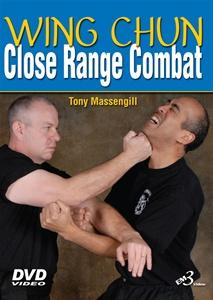Review of Tony Massengill's Close Range Combat DVD
Customer/3rd Party Review: This review was done by a customer/3rd party and is listed here for you reference only. The views and opinions of the reviewer are not those of Everything Wing Chun and do not necessarily reflect EWC's views or opinions on the subject matter. It is posted, like all customer reviews, to give you more info on the product and to give you different opinions on a product so that you can make the best decision for yourself about its content. The review is NOT by an EWC employee or contractor and EWC cannot stand by anything said in any customer/3rd party review. Enjoy!
Reviewer: George Hernandez
Date: May 14, 2011
DVD Bought on: Everything Wing Chun : http://www.everythingwingchun.com/tony-massengill-wing-chun-dvds-books-s/244.htm
Technical Specifications:
Title: Tony Massengill Wing Chun Kung Fu Close Range Combat
DVD Length: 1 hour 4 mins
Region: 0
Type: DVD-R
Format: NTSC
Video Quality:Above Average
Audio Quality: 5/5 (Professional)
What It's About:
Sifu Massengill presents applications of the close range fighting techniques of the Wing Chun Kung-fu system.
Comments:
If you’re looking for a DVD that demonstrates genuine Wing Chun Kung-Fu technique, then this is the video for you. The production is excellent and Sifu Massengill presents the material expertly. In this DVD as in others, Massengill maintains the philosophy that the sport martial art environment is quite different from the street. So attitude and application is indeed quite different in situations from the Koon or School.
One’s practice in Kung-fu should not focus on looking flashy or showy, but to get the job done in the quickest manner possible. In fact Wing Chun doesn’t appear all that elaborate when compared with other forms of Kung fu, such as Praying Mantis or Hung-Gar. But, don’t deceive yourself; Wing Kung is quite elegant in its close range techniques. Sifu Massengill demonstrates effectively the principles of the Wing Chun System showing how one can exploit the situation at point of contact with an adversary.
There’s lots of practical advice which is presented in this DVD relevant to the street environment, such as maintaining a stance of non-aggression for legal reasons, but being prepared in case a fight should in sue. One can appreciate Sifu Massengill’s emphasis on the basics, which is that power at close range comes from one’s structure or root. The old analogy that a house is only as strong as its foundation applies here. Massengill demonstrates the fundamentals of Wing Chun, by showing how the techniques are based on sound biomechanics and are effective according to the natural structure of the body.
Again, if you’re looking for a DVD, that truly represents the principles behind close range fighting of the Wing Chun System, then this DVD would be an excellent investment. By watching Sifu Massengill’s demonstration of Wing Chun, one would readily see that he comes from a genuine lineage of Wing Chun Kung- fu. He presents his lineage as that from Ip man, Ip man’s two sons and Samual Kwok. If Wing Chun lineage is important as far as training and school affiliation, then indeed, this instructional DVD would be a real treat!
Content Overview:
Introduction
The essential principles associated with Wing Chun’s close in fighting techniques
- The fighting environment.
- Sports MA and Movies distort the fighting environment
- Distance, applications, tools and weapons
- There are only two ranges.
- The bridge-coming into contact
- Contact – 12 points of contact.
- The anatomy of a punch.
- Structural components
- Shoulder position.
- Using the body at short range
- The biomechanics of motion.
- Where does the power come from?
- The rooted base.
- Power from the shoulder not the arm.
- The lower arm position
- Controlling structure along the line.
- The Graduated Training process and bridging drills.
- The interview position – non-aggression posture.
- Bridge contact at centerline.
- Cross drill with Jet Sao.
- Control is the Objective.
- Training should be developed to represent reality.
- Legal aspects and common sense.
- Acquiring control from being grasped
- Opening the line
- Pac Sao with a sealing maneuver.
- The benefit of hitting twice.
- Blood born diseases and using the open hand.
- The returning fist.
- Using the opponent’s had.
- Using focus pads in training.
- Kicking a close range.
- Preloading and using the knee.
- Kicking at the correct angle.
- Using kicks for setting up Chin Na techniques
other blogs by user


